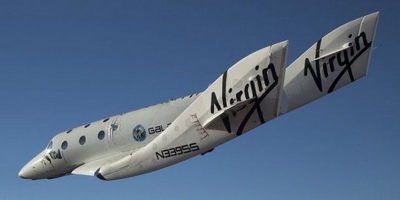Scaled Composites Model 339 Space Ship Two - Machtres Fighters
Main menu
- index
- Air Services
-
Planes
- list
- Weapons
- Gallery
- transport
- liners
- X projects
- Air Forces
- Air Disasters
- red-bull
- Specials
- Choppers
- History
- Aircraft Carriers
-
Information
- Argentine
- Space
Scaled Composites Model 339 Space Ship Two
The Scaled Composites Model 339 SpaceShipTwo (SS2) is a suborbital horizontal-
The SpaceShipTwo project is based in part on technology developed for SpaceShipOne as part of the Scaled Composites Tier One program, funded by Paul Allen. The Spaceship Company licenses this technology from Mojave Aerospace Ventures, a joint venture of Paul Allen and Burt Rutan, the designer of the predecessor technology.  SpaceShipTwo is a low-
SpaceShipTwo is a low-
This aircraft article is missing some (or all) of its specifications. If you have a source, you can help Wikipedia by adding them.
SpaceShipTwo uses a feathered reentry system, feasible due to the low speed of re-
SpaceShipTwo will decelerate through the atmosphere, switching to a gliding position at 80,000 ft and will take 25 minutes to glide back to the spaceport. Once the passengers return, their passports will receive a spaceflight stamp and they will be awarded their astronaut wings at an awards ceremony. They will also be able to relive their flight from footage filmed during the spaceflight.
SpaceShipTwo and its new carrier aircraft, White Knight Two, are roughly twice the size of the first generation spacecraft SpaceShipOne and mothership White Knight that won the Ansari X Prize. SpaceShipTwo will have 43 cm and 33 cm (17 and 13 in) diameter windows for the passengers' viewing pleasure, and all seats will recline back during landing to decrease the discomfort of G-
During the early test phase of Space Ship Two's system on 26 July 2007 an explosion occurred during a fuel flow test at the Mojave Air & Space Port. The test included filling the oxidizer tank with 4,500 kg (10,000 pounds) of nitrous oxide followed by a 15 second cold flow injector test.[citation needed] Although the tests did not ignite the gas, three employees were killed and three injured, two critically and one seriously, from shrapnel wounds.
Burt Rutan remarked on the safety of the vehicle:
"This vehicle is designed to go into the atmosphere in the worst case straight in or upside down and it'll correct...This is designed to be at least as safe as the early airliners in the 1920s...Don't believe anyone that tells you that the safety will be the same as a modern airliner, which has been around for 70 years."
Flight test program
In October 2009, Virgin Galactic CEO Will Whitehorn outlined the flight test program for SpaceShipTwo. The test program will include seven phases: vehicle ground testing, captive carry under WhiteKnightTwo, unpowered glide testing, subsonic testing with only a brief firing of the rocket, supersonic atmospheric testing, then rocket into suborbital space, and finally execute a detailed and lengthy process with US Federal government regulator FAA/AST to demonstrate system robustness and eventually obtain a commercial launch license to begin commercial operations.
On Monday March 22, 2010, the SpaceShipTwo vehicle VSS Enterprise underwent a captive carry test flight, whereby the parent WhiteKnightTwo performed a short flight with the SpaceShipTwo being carried by the WhiteKnightTwo. A second test flight was made on May 16, 2010 The flight reached launch altitude (51,000 feet) and lasted for a duration of nearly five hours in order to facilitate "cold soak" testing of SS2's avionics and pressurization system. "A simulated spaceship descent/glide mission was made from altitude." The SpaceShipTwo airframe was modified between captive carry flight 1 and flight 2 by the addition of two interior fins, one to the inside (rocket-
On July 15, 2010 VSS Enterprise made its first crewed flight. The craft remained attached to VMS Eve as planned and underwent a series of combined vehicle systems tests. The flight lasted 6 hours and 21 minutes.
A second, and similar, crewed flight of VSS Enterprise and VMS Eve was carried out on 30 Sept 10 lasting 5 hours. Improving pilot proficiency was among the objectives and the results add confidence that the systems are capable of supporting future glide missions.
On October 10, 2010 VSS Enterprise made its first manned gliding test flight, after being released from VMS Eve at 45,000 feet. The second gliding test flight took place on the 28th of October 2010 and the third on Wednesday 17 November 2010.
As of December 2010, Scaled reported that the flight test program is exceeding expectations,. The fourth test flight took place in January 2011.
NASA sRLV program
As of March 2011, Virgin Galactic has submitted SpaceShipTwo as a reusable launch vehicle for carrying research payloads in response to NASA's suborbital reusable launch vehicle (sRLV) solicitation, which is a part of NASA's Flight Operations Program. Virgin projects 110 km (68 mi) altitude in flights of approximately 90 minutes duration, while carrying a research payload. Flights will provide approximately four minutes of microgravity. Payload mass and microgravity levels have not yet been specified. The NASA research flights could begin during the test flight certification program for SpaceShipTwo.
Launch siteThe SpaceShipTwo craft will take off from the Mojave Air & Space Port in California during testing. Spaceport America (formerly Southwest Regional Spaceport), a US$212 million spaceport in New Mexico partly funded by the state government, will become the permanent launch site when commercial launches begin. The company is also exploring launches from spaceports in the UK.